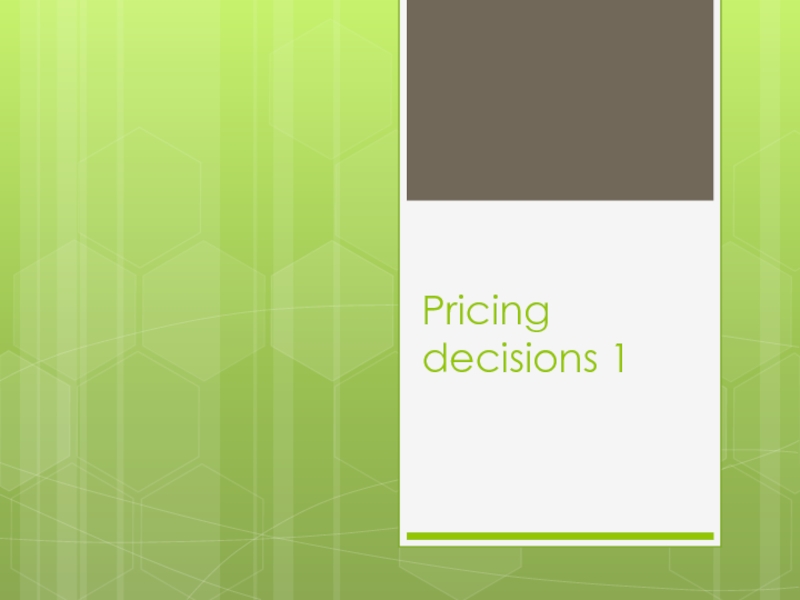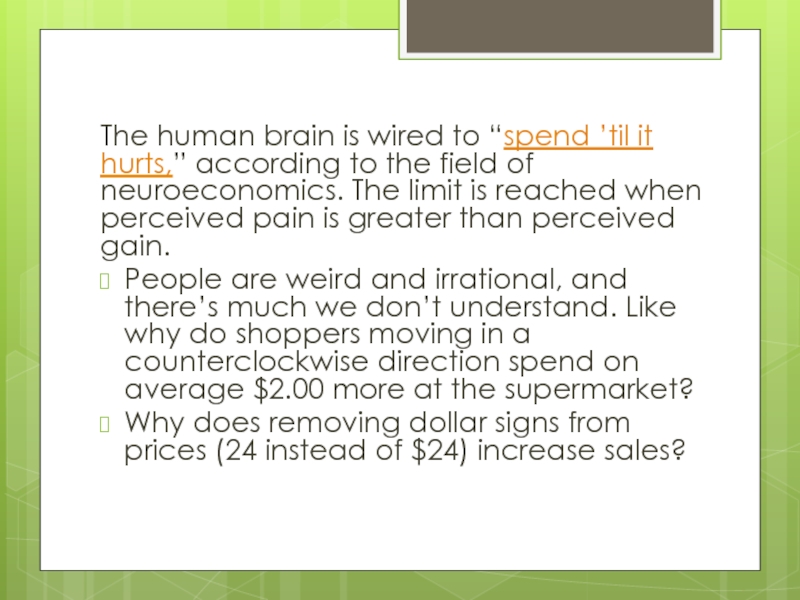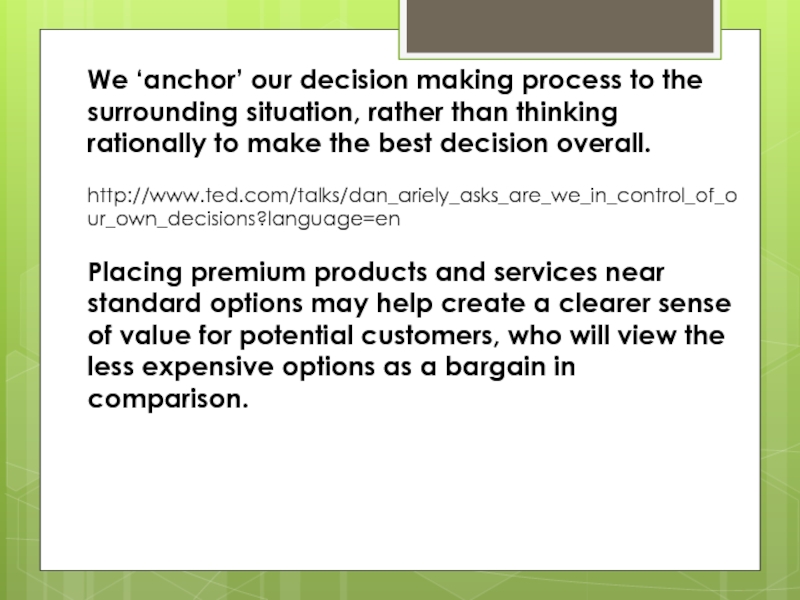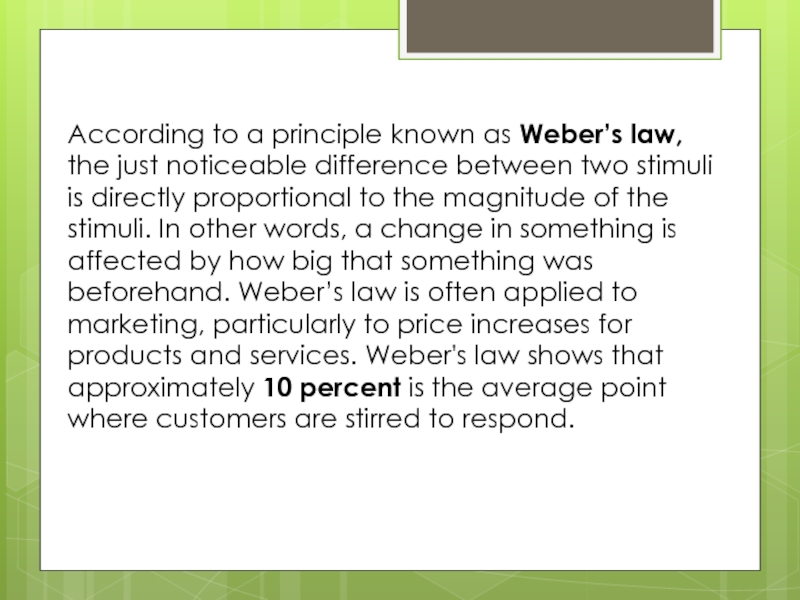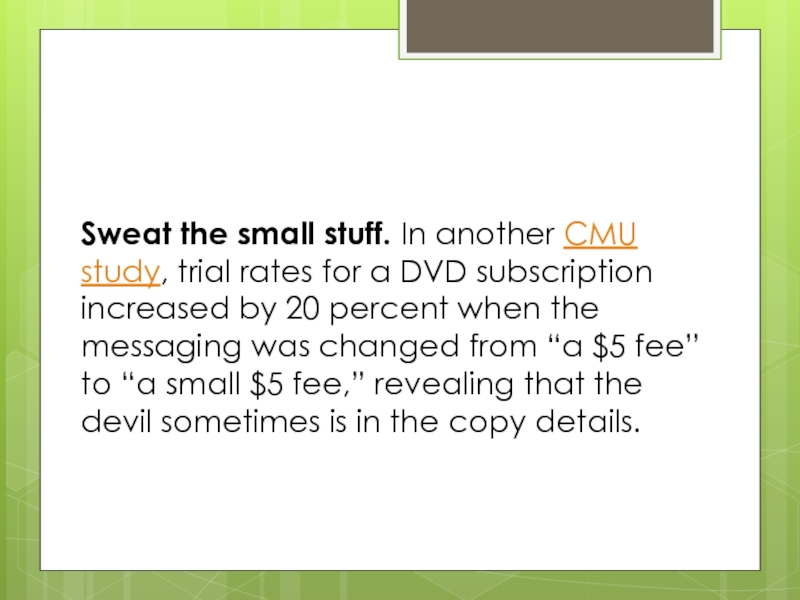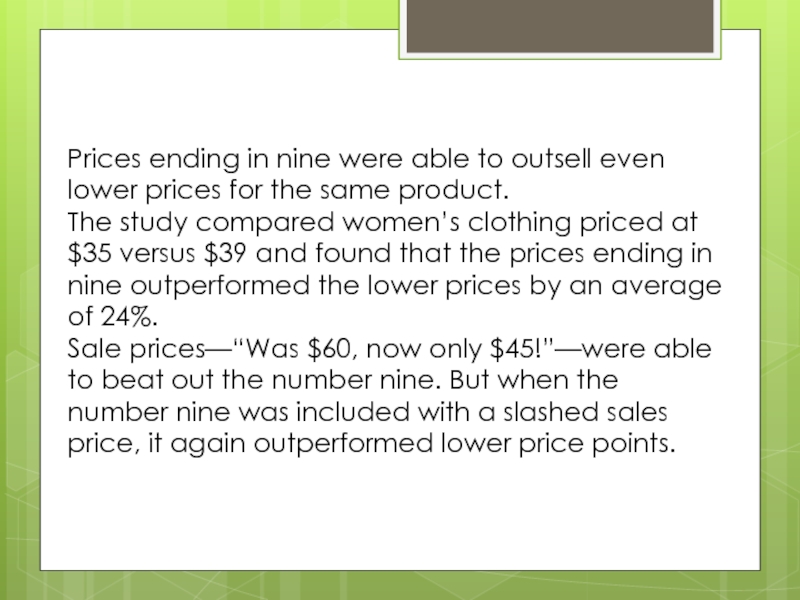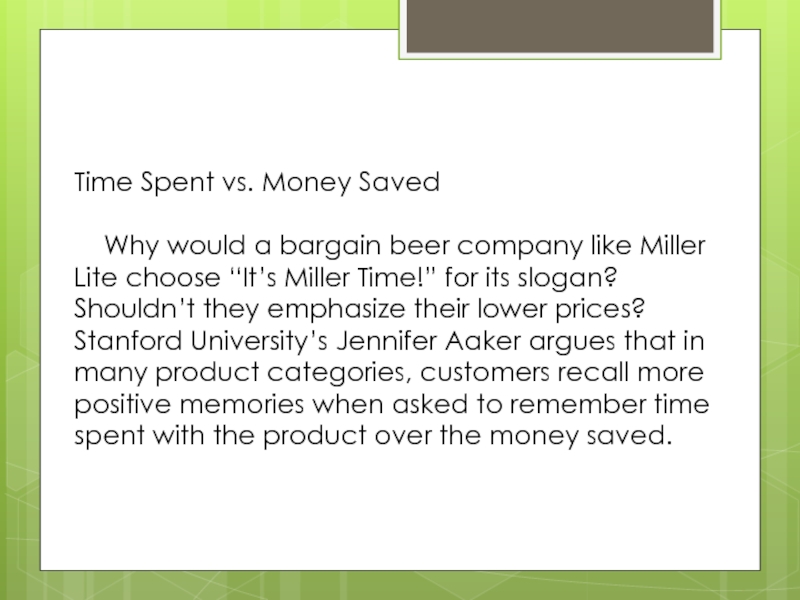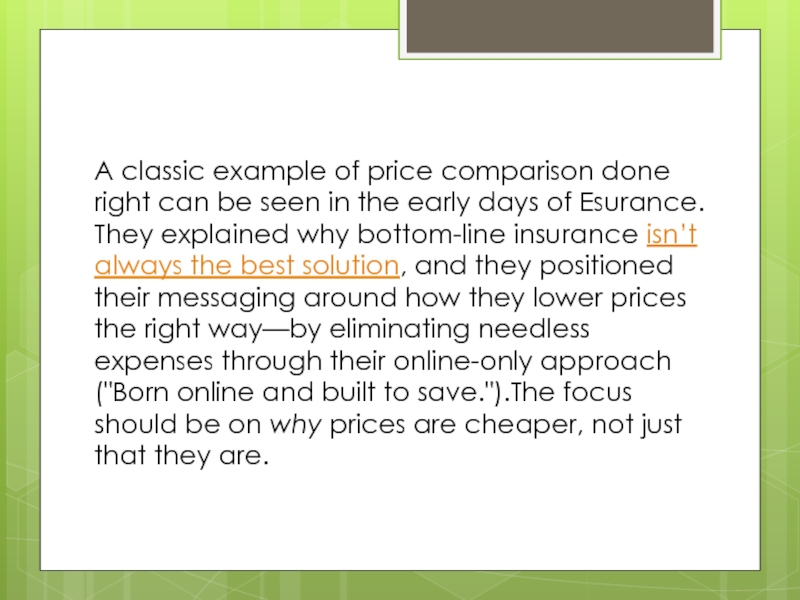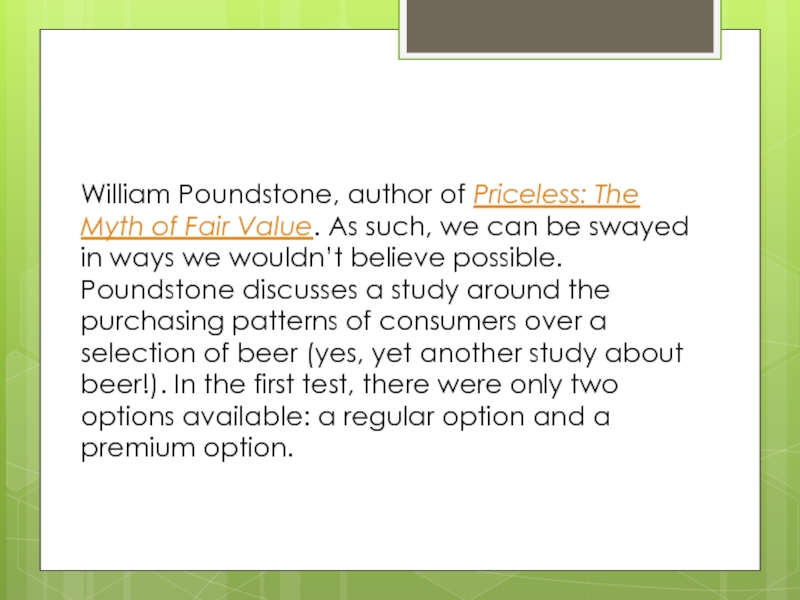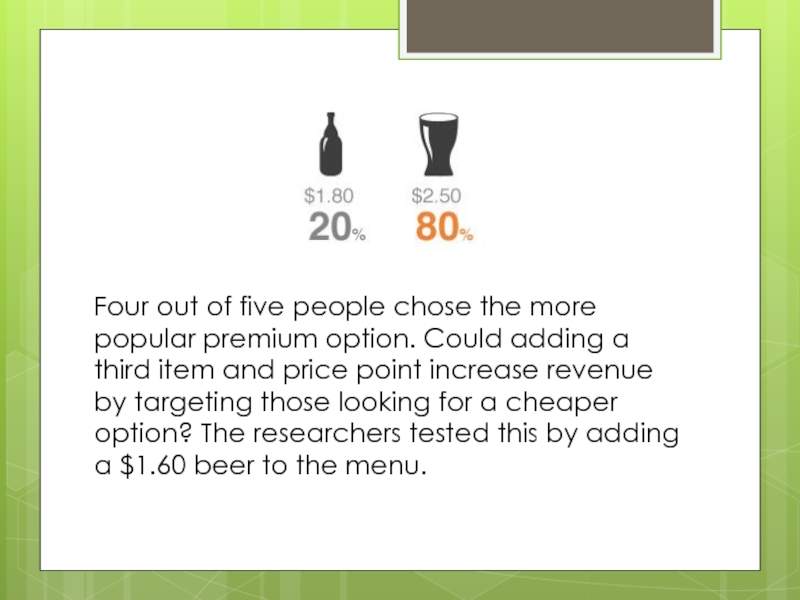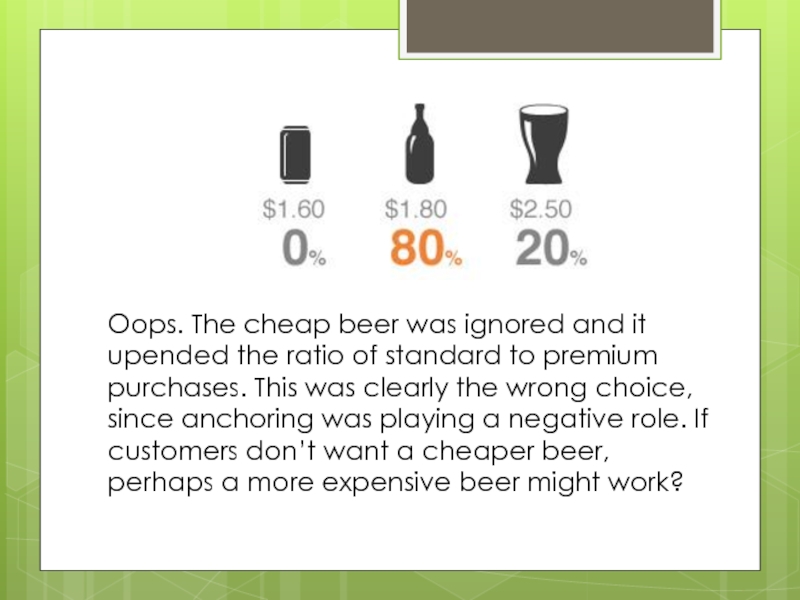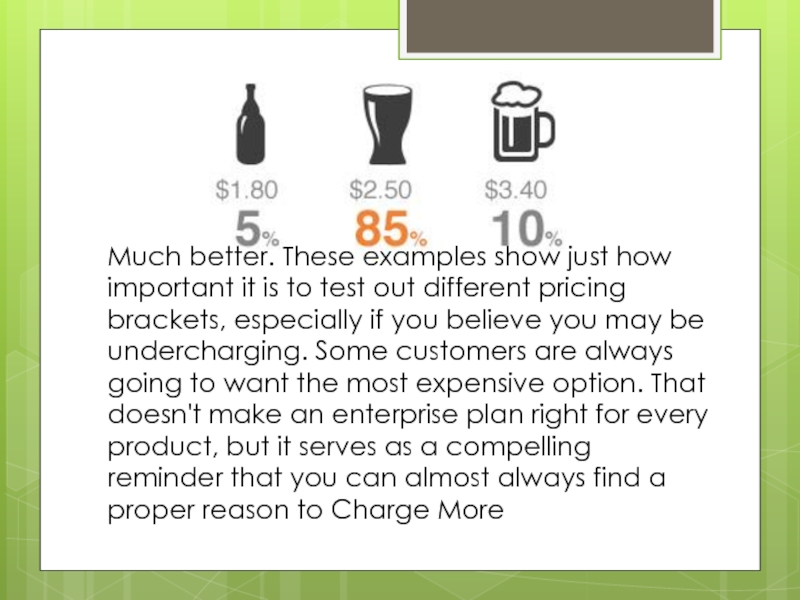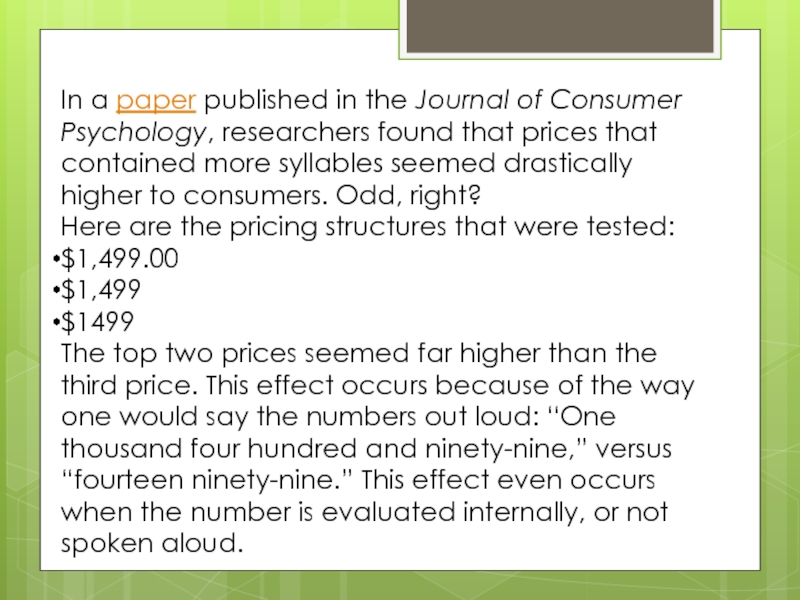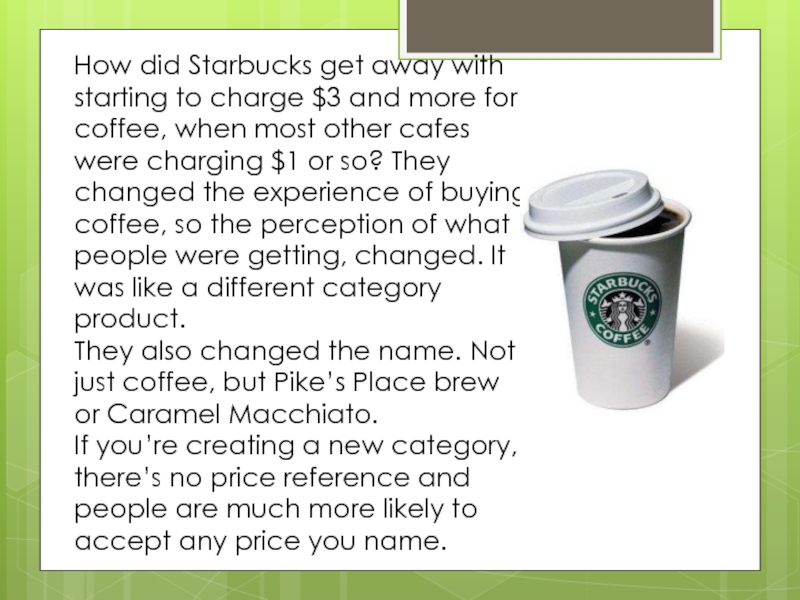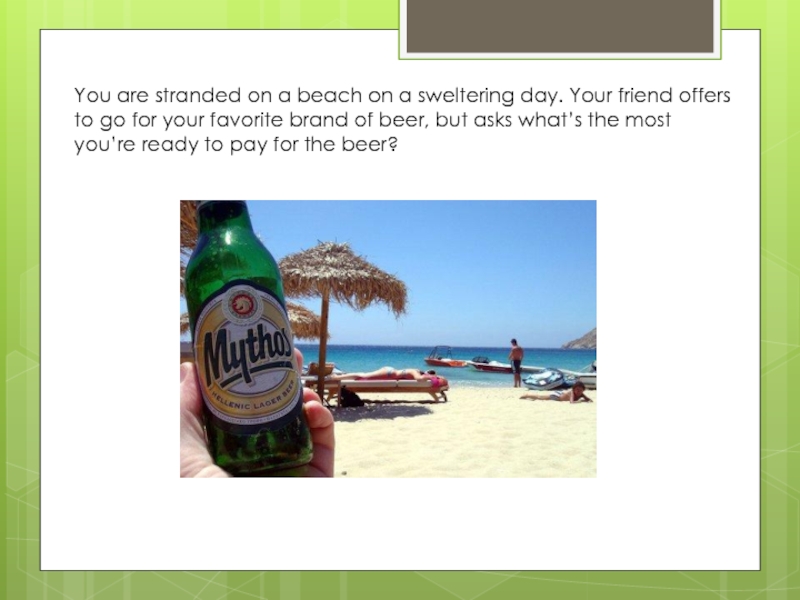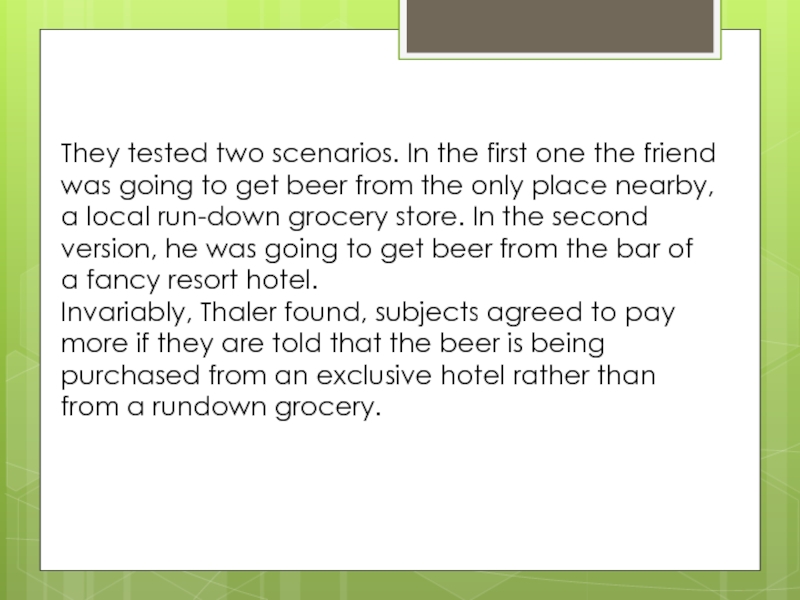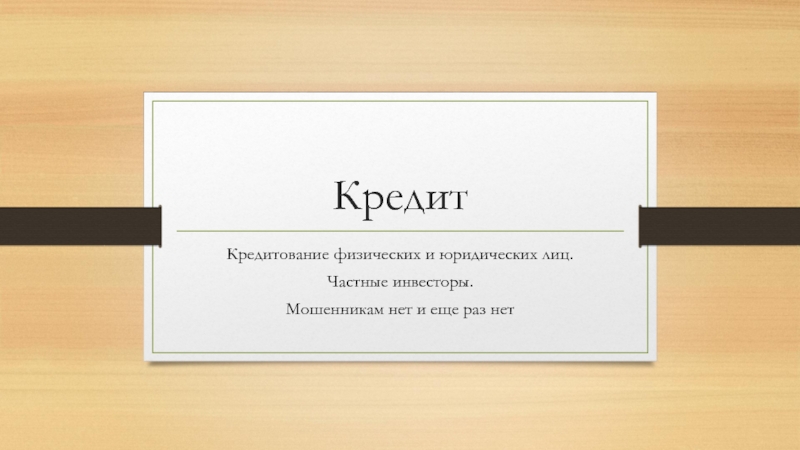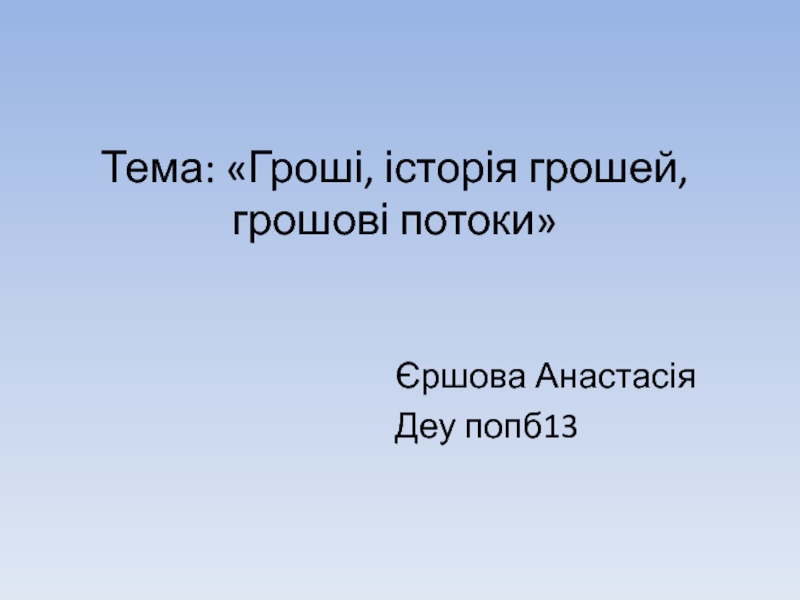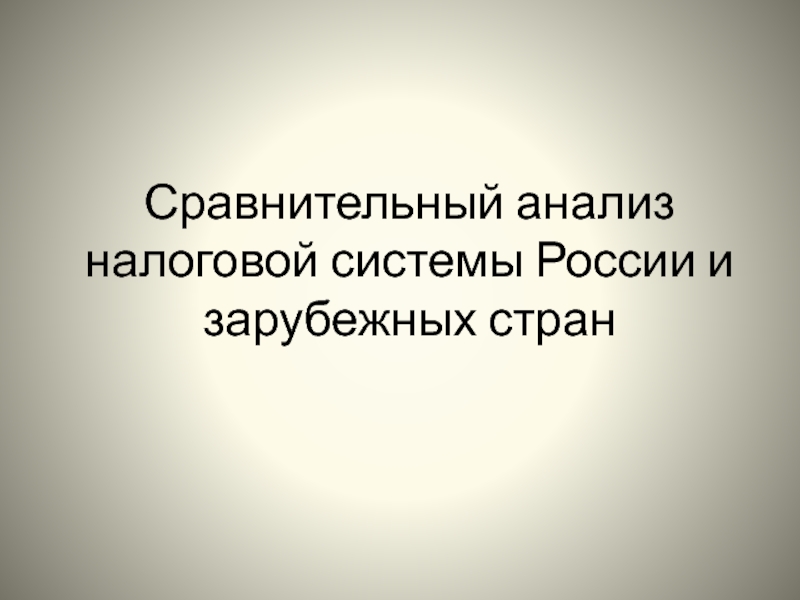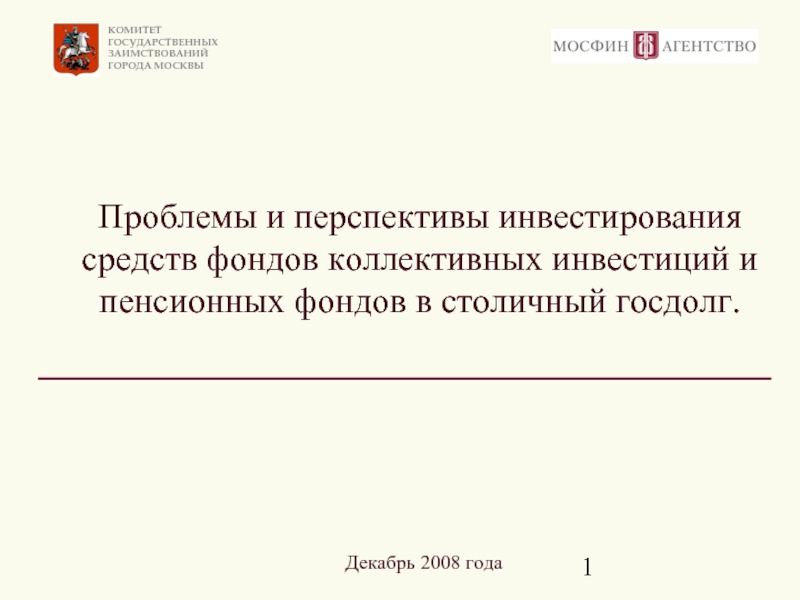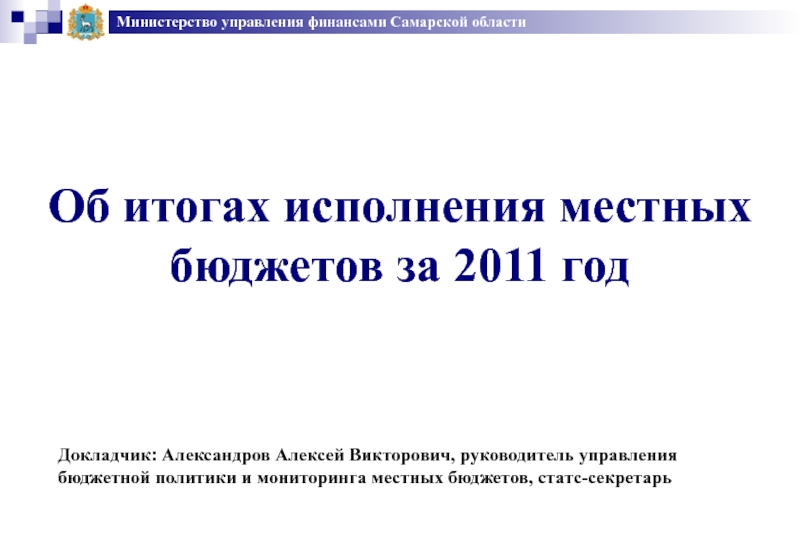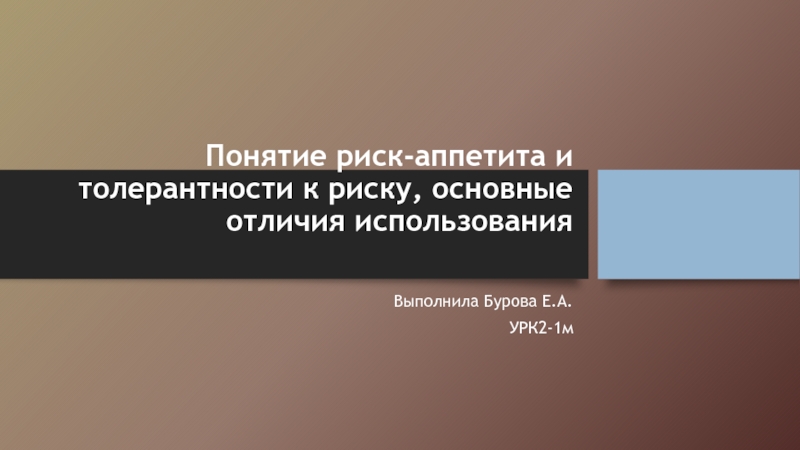- Главная
- Разное
- Дизайн
- Бизнес и предпринимательство
- Аналитика
- Образование
- Развлечения
- Красота и здоровье
- Финансы
- Государство
- Путешествия
- Спорт
- Недвижимость
- Армия
- Графика
- Культурология
- Еда и кулинария
- Лингвистика
- Английский язык
- Астрономия
- Алгебра
- Биология
- География
- Детские презентации
- Информатика
- История
- Литература
- Маркетинг
- Математика
- Медицина
- Менеджмент
- Музыка
- МХК
- Немецкий язык
- ОБЖ
- Обществознание
- Окружающий мир
- Педагогика
- Русский язык
- Технология
- Физика
- Философия
- Химия
- Шаблоны, картинки для презентаций
- Экология
- Экономика
- Юриспруденция
Pricing decisions презентация
Содержание
- 1. Pricing decisions
- 2. The human brain is wired to “spend
- 3. If two similar items are priced the
- 4. We ‘anchor’ our decision making process to
- 5. According to a principle known as Weber’s
- 6. Sweat the small stuff. In another CMU
- 7. Prices ending in nine were able to
- 8. Time Spent vs. Money Saved
- 9. A classic example of price comparison done
- 10. William Poundstone, author of Priceless: The Myth
- 11. Four out of five people chose the
- 12. Oops. The cheap beer was ignored and
- 13. Much better. These examples show just how
- 14. In a paper published in the Journal
- 15. How did Starbucks get away with starting
- 16. You are stranded on a beach on
- 17. They tested two scenarios. In the first
Слайд 2The human brain is wired to “spend ’til it hurts,” according
to the field of neuroeconomics. The limit is reached when perceived pain is greater than perceived gain.
People are weird and irrational, and there’s much we don’t understand. Like why do shoppers moving in a counterclockwise direction spend on average $2.00 more at the supermarket?
Why does removing dollar signs from prices (24 instead of $24) increase sales?
People are weird and irrational, and there’s much we don’t understand. Like why do shoppers moving in a counterclockwise direction spend on average $2.00 more at the supermarket?
Why does removing dollar signs from prices (24 instead of $24) increase sales?
Слайд 3If two similar items are priced the same, consumers are often
less likely to buy one than if their prices are even slightly different.
In one experiment, researchers gave users a choice of buying a pack of gum or keeping the money. When given a choice between two packs of gum, only 46% made a purchase when both were priced at 63 cents. Conversely, when the packs of gum were differently priced—at 62 cents and 64 cents—more than 77% of consumers chose to buy a pack.
When similar items have the same price, consumers are inclined to defer their decision instead of taking action.
In one experiment, researchers gave users a choice of buying a pack of gum or keeping the money. When given a choice between two packs of gum, only 46% made a purchase when both were priced at 63 cents. Conversely, when the packs of gum were differently priced—at 62 cents and 64 cents—more than 77% of consumers chose to buy a pack.
When similar items have the same price, consumers are inclined to defer their decision instead of taking action.
Слайд 4We ‘anchor’ our decision making process to the surrounding situation, rather
than thinking rationally to make the best decision overall.
http://www.ted.com/talks/dan_ariely_asks_are_we_in_control_of_our_own_decisions?language=en
Placing premium products and services near standard options may help create a clearer sense of value for potential customers, who will view the less expensive options as a bargain in comparison.
http://www.ted.com/talks/dan_ariely_asks_are_we_in_control_of_our_own_decisions?language=en
Placing premium products and services near standard options may help create a clearer sense of value for potential customers, who will view the less expensive options as a bargain in comparison.
Слайд 5According to a principle known as Weber’s law, the just noticeable
difference between two stimuli is directly proportional to the magnitude of the stimuli. In other words, a change in something is affected by how big that something was beforehand. Weber’s law is often applied to marketing, particularly to price increases for products and services. Weber's law shows that approximately 10 percent is the average point where customers are stirred to respond.
Слайд 6Sweat the small stuff. In another CMU study, trial rates for
a DVD subscription increased by 20 percent when the messaging was changed from “a $5 fee” to “a small $5 fee,” revealing that the devil sometimes is in the copy details.
Слайд 7Prices ending in nine were able to outsell even lower prices
for the same product.
The study compared women’s clothing priced at $35 versus $39 and found that the prices ending in nine outperformed the lower prices by an average of 24%.
Sale prices—“Was $60, now only $45!”—were able to beat out the number nine. But when the number nine was included with a slashed sales price, it again outperformed lower price points.
The study compared women’s clothing priced at $35 versus $39 and found that the prices ending in nine outperformed the lower prices by an average of 24%.
Sale prices—“Was $60, now only $45!”—were able to beat out the number nine. But when the number nine was included with a slashed sales price, it again outperformed lower price points.
Слайд 8Time Spent vs. Money Saved
Why would a bargain beer
company like Miller Lite choose “It’s Miller Time!” for its slogan? Shouldn’t they emphasize their lower prices? Stanford University’s Jennifer Aaker argues that in many product categories, customers recall more positive memories when asked to remember time spent with the product over the money saved.
Слайд 9A classic example of price comparison done right can be seen
in the early days of Esurance. They explained why bottom-line insurance isn’t always the best solution, and they positioned their messaging around how they lower prices the right way—by eliminating needless expenses through their online-only approach ("Born online and built to save.").The focus should be on why prices are cheaper, not just that they are.
Слайд 10William Poundstone, author of Priceless: The Myth of Fair Value. As
such, we can be swayed in ways we wouldn’t believe possible. Poundstone discusses a study around the purchasing patterns of consumers over a selection of beer (yes, yet another study about beer!). In the first test, there were only two options available: a regular option and a premium option.
Слайд 11Four out of five people chose the more popular premium option.
Could adding a third item and price point increase revenue by targeting those looking for a cheaper option? The researchers tested this by adding a $1.60 beer to the menu.
Слайд 12Oops. The cheap beer was ignored and it upended the ratio
of standard to premium purchases. This was clearly the wrong choice, since anchoring was playing a negative role. If customers don’t want a cheaper beer, perhaps a more expensive beer might work?
Слайд 13Much better. These examples show just how important it is to
test out different pricing brackets, especially if you believe you may be undercharging. Some customers are always going to want the most expensive option. That doesn't make an enterprise plan right for every product, but it serves as a compelling reminder that you can almost always find a proper reason to Charge More
Слайд 14In a paper published in the Journal of Consumer Psychology, researchers
found that prices that contained more syllables seemed drastically higher to consumers. Odd, right?
Here are the pricing structures that were tested:
$1,499.00
$1,499
$1499
The top two prices seemed far higher than the third price. This effect occurs because of the way one would say the numbers out loud: “One thousand four hundred and ninety-nine,” versus “fourteen ninety-nine.” This effect even occurs when the number is evaluated internally, or not spoken aloud.
Here are the pricing structures that were tested:
$1,499.00
$1,499
$1499
The top two prices seemed far higher than the third price. This effect occurs because of the way one would say the numbers out loud: “One thousand four hundred and ninety-nine,” versus “fourteen ninety-nine.” This effect even occurs when the number is evaluated internally, or not spoken aloud.
Слайд 15How did Starbucks get away with starting to charge $3 and
more for coffee, when most other cafes were charging $1 or so? They changed the experience of buying coffee, so the perception of what people were getting, changed. It was like a different category product.
They also changed the name. Not just coffee, but Pike’s Place brew or Caramel Macchiato.
If you’re creating a new category, there’s no price reference and people are much more likely to accept any price you name.
They also changed the name. Not just coffee, but Pike’s Place brew or Caramel Macchiato.
If you’re creating a new category, there’s no price reference and people are much more likely to accept any price you name.
Слайд 16You are stranded on a beach on a sweltering day. Your
friend offers to go for your favorite brand of beer, but asks what’s the most you’re ready to pay for the beer?
Слайд 17They tested two scenarios. In the first one the friend was
going to get beer from the only place nearby, a local run-down grocery store. In the second version, he was going to get beer from the bar of a fancy resort hotel.
Invariably, Thaler found, subjects agreed to pay more if they are told that the beer is being purchased from an exclusive hotel rather than from a rundown grocery.
Invariably, Thaler found, subjects agreed to pay more if they are told that the beer is being purchased from an exclusive hotel rather than from a rundown grocery.
